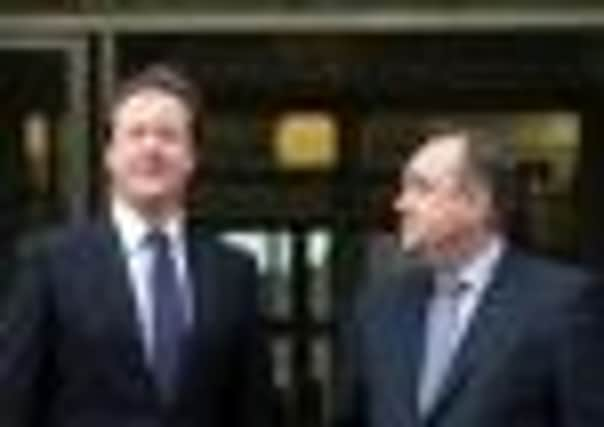Growth takes a dip but jobs raise prospect of Scottish recovery


Gross domestic product figures for the last three months of 2011 showed a 0.1 per cent fall in growth, less than expected, and lower than the fall across the UK, which recorded a 0.3 per cent reverse.
But if another retraction is recorded for the first three months of this year, the country would technically re-enter the recession it crawled out of in the first half of 2009.
Advertisement
Hide AdAdvertisement
Hide AdThe mood yesterday was lightened by the surprise fall in unemployment for the December-to-February period, offering hope that the economy picked up in the new year.
Economists and business leaders said that while there was room for cautious hope, the economy remained highly vulnerable to any further shocks from Europe.
Scotland’s better performance relative to the UK was due mostly to a strong performance from its business services and finance sector, and from the electricity and gas supply market.
But any growth was off-set by falls in manufacturing, and construction. The latter sector, which was in part responsible for hoisting the country out of recession in 2010, has now shrunk for five consecutive quarters. In 2011, the sector slipped back by 8.5 per cent.
That poor performance saw First Minister Alex Salmond yesterday making fresh calls on the UK government to open the purse strings and give him more money for infrastructure investment.
“What is needed now to propel recovery forward is an injection of increased capital spending – which is why I am writing again to David Cameron with the list of £300 million of ‘shovel-ready’ projects across Scotland to boost growth and support thousands of jobs,” Mr Salmond said.
Opposition parties last night said that if the First Minister was serious he could find the cash from his own £30 billion-a-year budget, noting how the SNP had itself decided to slash its housing budget by £100m in its recent spending plans.
The fall in manufacturing was largely caused by a slump in metals, refined petroleum, chemical and pharmaceutical products, as well as food and tobacco.
Advertisement
Hide AdAdvertisement
Hide AdBy contrast, there were significant annual increases in other sectors, such as transport equipment (7.9 per cent) and textiles, clothing and leather (19.4 per cent), both of which have returned to pre-recession levels.
Over the course of the year, the food and drink sector made the largest contribution to annual growth, with an increase of 8.4 per cent.
Most economists believe that the UK and Scotland will avoid falling into a recession this year – defined as two successive quarters of negative growth. But there remains an outside chance that parts of the country could fall back into a slump when the figures for the first quarter of 2012 are released.
Scotland suffered five successive negative quarters between June 2008 and October 2009, since when it has remained marginally in the black.
Professor Brian Ashcroft, director of the Fraser of Allander Institute at Strathclyde University, said: “The feeling was that we would see one negative quarter. I think it will be broadly flat after that. It will be close to a double-dip.”
Prof Ashcroft said that while the Scottish economy has grown since 2009, it was still 4 per cent below its output immediately before the recession, showing how the country had still to make up for the lost ground following the crash.
“We are really still bumping along the bottom. On top of that, the problems in the eurozone could come back,” he said.
Yesterday’s figures also revised down the figures for the third quarter of 2011, from 0.5 per cent growth to 0.4 per cent. Growth in the second quarter of last year was also revised down to zero from 0.2 per cent. Overall, it left overall growth in 2011 at just 0.5 per cent over the course of the year.
Advertisement
Hide AdAdvertisement
Hide AdLittle is expected to change this year, with Fraser of Allander having revised down its forecast from 0.9 per cent to 0.4 per cent. It believes a return to pre- recession output is unlikely before the third quarter of 2014 – six years after the start of the downturn.
Any prolonged recession is unlikely, however, with economists predicting that the fall in inflation should lead to a marginal pick-up in the latter part of this year.
In 2013, the economy will then pick up further, with growth expected to hit 1.7 per cent, the institute believes.
Business leaders said last night that while the good news in the labour market offered some comfort, there are still difficult times ahead.
Lesley Sawers, chief executive of the Scottish Council for Development and Industry (SCDI), said the fall in unemployment showed “increased confidence” among employers.
However, she added: “SCDI remains concerned by the stalling of economic recovery, both across the UK and the European Union. Returning to economic prosperity must remain a key concern of the Scottish and Westminster governments.”
Scottish Conservative finance spokesman Gavin Brown pointed to the fall in construction in Scotland, in contrast to the increase in the sector across the UK. “If we want to improve our growth, the Scottish Government has to take sufficient action as soon as possible,” he said.
Other figures yesterday showed that the value of Scottish exports was unchanged during the fourth quarter of 2011. However, over the year the volume of exports grew by 4.8 per cent.